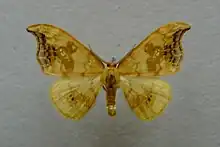Sabra harpagula
Sabra harpagula, the scarce hook-tip, is a moth of the family Drepanidae first described by Eugenius Johann Christoph Esper in 1786. It is found from Europe through temperate Asia to Japan.
| Sabra harpagula | |
|---|---|
 | |
| Scientific classification | |
| Kingdom: | |
| Phylum: | |
| Class: | |
| Order: | |
| Family: | |
| Genus: | |
| Species: | S. harpagula |
| Binomial name | |
| Sabra harpagula | |
| Synonyms | |
| |
The wingspan is 25–35 mm. The moth flies from June to August depending on the location.
The larvae feed on Tilia (including Tilia cordata), Quercus, Alnus and Betula species.
Subspecies
- Sabra harpagula harpagula (Europe, south-eastern Russia, Manchuria)
- Sabra harpagula bitorosa (Watson, 1968) (China: Sichuan, Shaanxi)
- Sabra harpagula emarginata (Watson, 1968) (China: Zhejiang, Fujian)
- Sabra harpagula euroista Park, 2011 (Korea)
- Sabra harpagula olivacea (Inoue, 1958) (Japan)
References
Wikimedia Commons has media related to Sabra harpagula.
Wikispecies has information related to Sabra harpagula.
External links
- Kimber, Ian. "65.006 BF1650 Scarce Hook-tip Sabra harpagula (Esper, 1786)". UKMoths. Retrieved 12 November 2019.
- Moths and Butterflies of Europe and North Africa
- Lepiforum e.V.
This article is issued from Wikipedia. The text is licensed under Creative Commons - Attribution - Sharealike. Additional terms may apply for the media files.